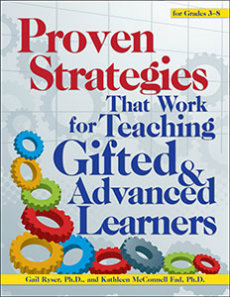A Quick Look at G&T Teaching Strategies
Proven Strategies That Work for Teaching Gifted and Advanced Learners
By Gail Ryser and Kathleen McConnell
(Prufrock Press, Inc. 2015 – Learn more)
Reviewed by Lisa Penrod
I teach middle school history, and when I tell people this, they look at me as if I have grown a second head. And when I tell them I have been doing it for 15 years and still love it, jaws drop and they question my sanity. I truly and completely love middle school students. They are the most unique, dynamic beings on the planet. I enjoy the challenge of opening their adolescent minds to new ideas and helping them to develop as learners.

With a gifted or honors class the potential for crazy-making is just magnified. Any time I come across a book that potentially has insights into how to attack the issues associated with this phenomenon, I eagerly devour it. This was what I hoped to find in this book. When it arrived, I was skeptical because it was only about 95 pages. Short books that address such an involved topic make me wary. Nonetheless, I was excited to see what nuggets of knowledge I could uncover.
Inside this short book
The book is organized into 20 chapters, each outlining a specific strategy aimed at third through eighth grade students. While perusing the table of contents, I was intrigued by many of the chapter titles such as “Hold That Thought” and “In-Class Acceleration.” The table of contents led me to believe that the book would give insight on everything from pre-assessment to in-class acceleration. However, I was setting myself up for disappointment.
The authors did provide some useful tips. One that seemed particularly intriguing to me was a strategy called “I Want to Know.” This offers a way for students to ask questions that would otherwise disrupt the lesson, as well as giving those students who desire to “dig deeper” a chance to do so. The concept is simple and begins with the teacher providing “I Want to Know” cards for students to write their questions. The teacher goes through the questions, chooses the relevant ones, and offers them up to the class as an opportunity for additional research. This is certainly something I can include in my classroom.
However, the problem with the book is that the authors attempt to provide solutions to the most complicated issues associated with addressing gifted children in about four pages each, and within those four pages the authors include the forms needed to carry out the strategy.
For example, two strategies for pre-assessment are provided. The first one is called “Four Step Pre-Assessment.” In this chapter, the authors attempt to address the concept of pre-assessment in seven very short paragraphs. The rest of the four pages is devoted to an example and the form. I am also confused by the choice of the example provided. The authors chose to use the topic of “How a bill becomes a law in the US.” As a teacher of history with 15 years of experience, I can honestly tell you that in our entire school, there may be one student capable of addressing this topic. This would be completely new information for them and, therefore, renders this type of pre-assessment useless.
Not enough substance
Ultimately, I was disappointed in this book. My main complaint: it attempts to address the “core” questions associated with teaching gifted students in a few hundred words each. Many of the strategies do not appear to be well-researched or well thought out. The instructions provided are often vague and the examples are limited.
While some of the ideas in the book have merit, the authors need to provide more explanation and a bigger variety of examples. I applaud their effort, but think they need to dig deeper and provide a book with more substance.
Lisa Penrod has taught 7th grade History/Social studies for the last 15 years at a Title I middle school in Rialto, CA. She teaches Gifted/Honors social studies (Medieval World History) and the AVID elective.




































I have one comment with regard to the choice of topic you mentioned that was used in the book. How a bill becomes a law is a favorite of mine; I teach 6th grade humanities in a gifted program and each year I incorporate that same topic in our curriculum. I begin with a background of the process and what student does not want to see, for the umpteenth time, the school house rock video. After an explanation, I divide the class (I generally teach 4 sections) into smaller groups. They then decide on a topic for which they would like to see a bill become a law. They then take a number of weeks, with weekly checkins, to work on their bills, which ultimately are voted on by the class as a whole. Overall, aside from some initial issues about who works best with who (another focus of the project) we come up with some pretty clever and well researched bills. A great project. Just saying….